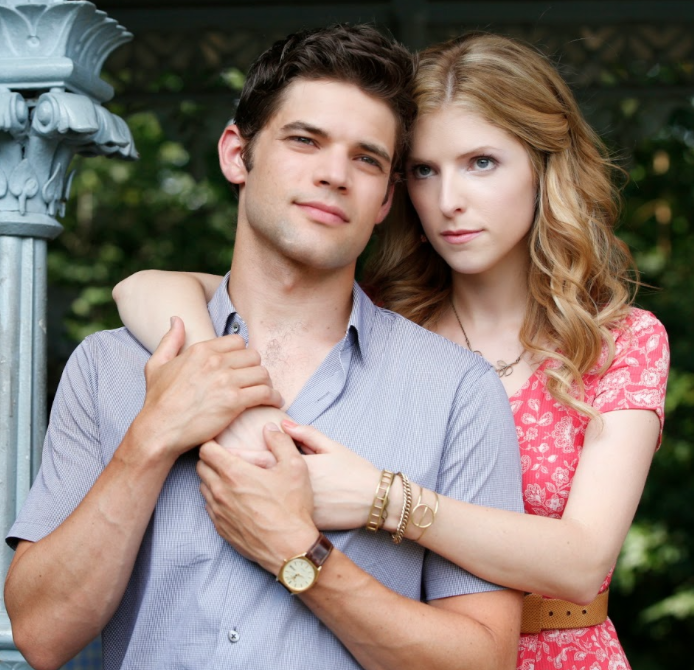 “The Last Five Years” may not be for people who don’t like musicals — it is almost entirely sung– but it does cover psychologically complex material that is a far cry from the typical Hollywood tuner. About the stormy relationship between Cathy (Anna Kendrick), a struggling stage actress, and Jamie (Jeremy Jordan), a successful young novelist, it grapples with a question rarely posed on screen or in polite company: Can romances work between two people who prize their artistic ambitions as much as each other?
“The Last Five Years” may not be for people who don’t like musicals — it is almost entirely sung– but it does cover psychologically complex material that is a far cry from the typical Hollywood tuner. About the stormy relationship between Cathy (Anna Kendrick), a struggling stage actress, and Jamie (Jeremy Jordan), a successful young novelist, it grapples with a question rarely posed on screen or in polite company: Can romances work between two people who prize their artistic ambitions as much as each other?
It’s an uncomfortable question, especially because it calls on the carpet the reality that, even now, most marriages only can handle one alpha if they’re to succeed. The fact that the question is set to music makes it easier to absorb and also more immediate. There’s an emotional accessibility (naysayers might call it ‘sentimentality’) to musicals that, to date, is unparalleled. And aided by wonderful melodies, the unusual combination of material and medium in “The Last Five Years” did prove a great, if short-lived, success off-Broadway. Adapted to screen by director/screenwriter Richard LaGravenese, it is also startlingly good.
LaGravenese’s best films have always explored romantic intimacy from odd angles; his 1998 debut feature, “Living Out Loud,” deserved far more kudos than it reaped. Here, he makes those odd angles literal. Using a hand-held (and steadi!) cam that swoops rather than shakes, he focuses wholly on his two leads, who do a good job of connecting with each other as their characters hurtle on opposite trajectories. Jamie sings his take on their story from the beginning of their relationship, Cathy goes backward from their breakup, and the two never duet except at the film’s midpoint — their wedding, fittingly. LaGravenese accentuates their “he sang/she sang” gap by sticking to the P.O.V. of whomever is singing, zooming in so tightly that all their emotions are writ large across their faces. We buy the couple’s chemistry partially because of the attentiveness each offers as the other sings. Kendrick in particular excels at nonverbal reactions.
Recently, I managed to divest myself of twenty-five followers when I tweeted that Anna Kendrick was one of the most versatile actresses of her generation. For those only familiar with the twenty-nine-year old actress’ work in the “Twilight” franchise, disdain was understandable. But, from her turn as a corporate stooge in “Up in the Air” to an insecure drunk in the indie “Happy Christmas,” Kendrick has established her chops. And, as evidenced in the movie musicals “Pitch Perfect,” “Camp,” and “Into the Woods,” Kendrick has singing chops, as well. She even got her start as a child actress on Broadway. (She was nominated for a Tony at age 12.) As her first lead in a true movie musical, “The Last Five Years” is Kendrick’s tour de force, and she sings her heart out, nearly breaking ours in the process. Jordan’s blandely handsome, bro-artist shtick isn’t always up to snuff — the vocally talented, Tony-nominated star of the Broadway smash “Newsies” may be more suited to the stage — but she compensates with an intensity that reads as the willful blindness of a woman in love.
The original production’s clever staging was part of its strength, as each lover sang alone on nearly empty sets. LaGravenese eschews sound stages for such real (and presumably more affordable) New York City locations as bars, parks, and stoops. Photographed in terrifically saturated color, the lovers’ widening gulf is emphasized instead through visual juxtaposition. Kathy’s expression of frozen misery is at the forefront when Jamie sings “I will not fail so you can be comfortable, Cathy/I will not lose because you can’t win.” In the number “A Summer in Ohio,” Jamie’s cooling ardor is palpable during a video chat in which Kathy regales him with song and dance while she’s off doing summerstock (a sign that her NYC career is not exactly blowing up). Aside from the “Star Is Born” movies, few films have captured the excruciating ambivalence that the pair feels as his star rises while she founders. She’s unwilling to shelf her dreams for his; he craves a girl who won’t rain on his parade. What’s most gloriously devastating are scenes in which the two are on the same page — glowing with their passion for each other as lovers and as artists — since we know from the film’s first minutes how it will end up.
As Valentine’s Day fare, this film may cut too close to the bone for all but the most hardened of hearts; who wants the truth about romance served up with their hearts and flowers? But as a worthy addition to the “Marriage Is Hard” chronicles that Hollywood is so fond of producing, “The Last Five Years” soars. Like love itself, it offers enough genuine pleasure to offset any unhappiness we may feel at the conclusion.
This review was originally published in Word and Film.
